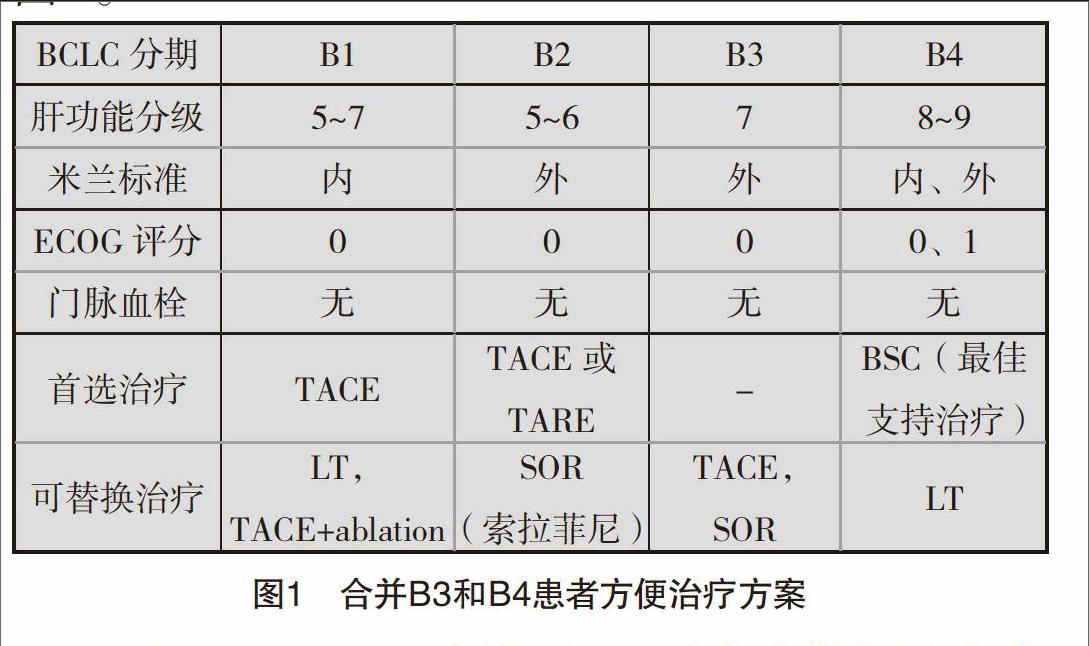巴塞罗那肝癌分期系统中肝癌患者的肝动脉化疗栓术
康敏 苏秀琴


【摘要】 肝細胞癌(HCC)是主要发生在肝硬化患者中的第五大常见癌症,需要分期系统来设计治疗。巴塞罗那诊所肝癌分期系统(BCLC)是最常用的肝癌治疗指南。对于BCLC B期(中间HCC),动脉化疗栓塞(TACE)是标准治疗。许多研究支持在早期和晚期HCC患者中使用TACE。对于BCLC 0期(非常早期的HCC),TACE可能是不适合射频消融(RFA)或肝切除术的患者的替代方案。在BCLC A期的患者中,TACE加RFA单独提供比RFA更好的局部肿瘤控制。TACE可作为等待肝移植患者的桥梁治疗。对于BCLC B期患者,与支持治疗方案相比,TACE提供了生存益处。然而,由于现阶段患者群体存在很大的异质性,因此需要更好的患者分层系统来选择TACE的最佳候选者。索拉非尼代表BCLC C期HCC患者的一线治疗。索拉非尼加TACE显示出延缓肿瘤进展的明显效果。另外,TACE加放疗在HCC患者和门静脉血栓形成患者中获得更好的生存。考虑到这些观察结果,TACE在HCC的每个阶段中作为独立或联合治疗在治疗HCC中显然具有关键作用。应将不同的治疗方式用于HCC患者,并应开发更好的患者分层系统,以选择TACE的最佳候选者。
【关键词】 肝细胞癌; 肝动脉化疗栓塞术; 巴塞罗那肝癌分期
Transcatheter Arterial Chemoembolization of Patients with Hepatocellular Carcinoma in the Staging System of Barcelona/KANG Min,SU Xiu-qin.//Medical Innovation of China,2017,14(14):143-148
【Abstract】 Hepatocellular carcinoma(HCC),the fifth most common cancer that predominantly occurs in liver cirrhosis patients,requires staging systems to design treatments.The barcelona clinic liver cancer staging system(BCLC) is the most commonly used HCC management guideline.For BCLC stage B(intermediate HCC),transarterial chemoembolization(TACE) is the standard treatment.Many studies support the use of TACE in early and advanced HCC patients.For BCLC stage 0(very early HCC),TACE could be an alternative for patients unsuitable for radiofrequency ablation(RFA) or hepatic resection.In patients with BCLC stage A,TACE plus RFA provides better local tumor control than RFA alone.TACE can serve as bridge therapy for patients awaiting liver transplantation.For patients with BCLC B,TACE provides survival benefits compared with supportive care options.However,because of the substantial heterogeneity in the patient population with this stage,a better patient stratification system is needed to select the best candidates for TACE.Sorafenib represents the first line treatment in patients with BCLC C stage HCC.Sorafenib plus TACE has shown a demonstrable effect in delaying tumor progression.Additionally,TACE plus radiotherapy has yielded better survival in patients with HCC and portal venous thrombosis.Considering these observations together,TACE clearly has a critical role in the treatment of HCC as a stand-alone or combination therapy in each stage of HCC.Diverse treatment modalities should be used for patients with HCC and a better patient stratification system should be developed to select the best candidates for TACE.
【Key words】 Hepatocellular carcinoma; Transarterial chemoembolization; Barcelona clinic liver cancer staging system
First-authors address:The Second Hospital of Shanxi Medical University,Taiyuan 030000,China
doi:10.3969/j.issn.1674-4985.2017.14.038
肝细胞癌(hepatic celluler cancer ,HCC),全世界最常见的癌症之一,其发病率和死亡率正在逐年增加[1]。主要发生在肝硬化患者,在中国主要发生在肝炎肝硬化患者,其恶性度高、预后差,未经治疗的肝癌患者平均生存期为3~6个月。大部分的患者确诊时已是中晚期,失去手术机会[2]。近年来治疗肝癌的手段在不断的发展,这就需要分期系统设计治疗方案。巴塞罗那肝癌临床分期(BCLC)是最常用的肝癌管理指南[3]。肝细胞癌是一种独特的肿瘤类型,因为除了肿瘤的本身恶性程度外,肝功能对预后也有很大影响[4]。巴塞罗那临床肝癌(BCLC)分期系统是最被广泛接受的,在全球范围内整合了肿瘤的特点及与肝功能一般状况,根据疾病的阶段为临床治疗选择提供了方案[5-7]。越来越多的证据支持TACE在早期和晚期肝癌患者中的应用。本文综述了关于TACE根据BCLC分期系统治疗肝癌的作用评价。
1 巴塞罗那肝癌分期系统与TACE
肝癌分期系统很多,其中包括TNM分期、意大利的CLIP分期、中国的大学预后指数(CUPI)、日本综合分期(JIS)系统,和BCLC分期与治疗策略[8-9]。在这些系统中,只有BCLC分期已被外部验证和分配管理选择以下五个不同类别的疾病:很早、早、中、晚期和终末期。重要的是,肝病专家组(EASL和AASLD)普遍认为巴塞罗那肝癌分期系统是首选,因为它有助于预测预后和治疗计划的选择[10-11]。因此总结了BCLC分期系统中每个疾病阶段和治疗策略,见表1。
根据BCLC系统,TACE是中期HCC的护理标准。如BCLC指南所述,这一层次的患者表现出来自TACE的生存获益,稍后将讨论。然而,在临床实践中,TACE已广泛应用于不同阶段的HCC,其范围超出BCLC系统(早期或甚至晚期HCC)推荐的阶段。无论TACE技术,化学治疗剂和治疗间隔的异质性如何,术语“常规TACE”通常指使用碘油作为栓塞物质。对于常规TACE,各种抗癌药物与碘油强力混合,碘油通过促进外排入门静脉,起到微血栓栓塞剂,化疗剂载体和抗肿瘤作用的增强作用[12]。作为常规的基于碘油的方案的替代方案,装载有细胞毒性药物的非吸收微球体可以在动脉内给予HCC患者。这些颗粒被称为“药物洗脱珠”,并被开发以从溶液中螯合多柔比星并以持续的方式释放它。据报道,与基于碘油的TACE相比,达到全身循环的化疗药物的量可以显着降低,从而急剧增加局部药物浓度[13]。Ⅱ期PRECISION Ⅴ试验将多柔比星负载的DEB与常规TACE进行比较,并显示出肝毒性和药物相关不良事件的显着降低。然而,到目前为止,没有前瞻性研究报告在基于碘油的TACE和DEB-TACE之间的临床疗效显示有差异[14]。在这里,笔者回顾了常规TACE在每个BCLC类别中的临床意义。
1.1 BCLC 0期(最早期) 这个阶段是指单个患者肿瘤≤2 cm。美国肝病研究协会(AASLD)和欧洲肝脏研究学会(EASL)建议肝切除术(HR)或肝移植(LT)作为0期的首先治疗手段[10-11]。然而,各种各样的风险使患者不能接受肝切除术或肝移植,如肝功能不全、大失血,而且缺乏供肝[15-16]。对于0期不适合用HR或LT的患者,多样化的局部消融技术已被采用。射频消融(RFA)被认为是选择的方式。研究证明,RFA对延长小肝癌患者的生存时间是有效的,而一些研究者认为,即使对于可以切除的单一的且大小≤2 cm肝癌患者,RFA可以作为此类患者的第一选择[17-18]。然而,对于肝肿瘤在包膜下或圆顶的位置或肝癌邻近主要胆管或肠道的患者,有一定的风险,包括肠穿孔、大出血、胆漏等[19],因而对于此类患者,RFA是不可行的。在0期TACE以往只考虑用于不能行HR、RFA、LT治疗的患者。Kim等[20]比较了TACE和RFA治疗0期肝癌的疗效,尽管RFA表现出更好的肿瘤反应和延缓肿瘤进展,但两组总生存率比较差异无统计学意义(P>0.05)。因而对于肿瘤大小2 cm或更小的肿瘤时,TACE可能被认为是一个可行的替代RFA治疗方式。
1.2 BCLC A期 这阶段患者一个结节或多达三个结节<3 cm。目前,如果患者肝功能很好,没有大血管或淋巴管浸润,肝切除术认为是标准的治疗早期肝癌的手段[11]。不幸的是,在这个阶段,肝癌通常发生在肝硬化基础上,并不能用肝切除术。RFA是单个直径<5 cm的肝细胞癌的一线治疗手段是被普遍认同的[21]。局部肿瘤进展率是RFA治疗HCC预后的重要因素,然而据报道,对于超过3 cm大小的肿瘤局部进展率大幅提高[22-23]。RFA很少有可能使>5 cm的肿瘤完全消融,消融区比较局限[24]。Jin等[25]比较RFA和TACE联合RFA治疗中小型(3~5 cm)肝癌的有效性和安全性。在聯合治疗组中,长期的局部肿瘤进展率均低于RFA组(1、3、5、7年分别进展率为9%、40%、55%、66%和45%、76%、86%和89%,P<0.001)。BCLC分期中早期只要是单发的没有血管浸润的无论肿瘤大小是否大于5 cm均是A期。Jin等[26]比较HR和TACE治疗孤立性大肝癌的疗效,报告显示,手术组1、3、5年累计生存率显著高于TACE组(分别为83.2%、75.7%、65.002%和68.5%、45.0%、17.502%,P<0.01)。不考虑肿瘤大小,手术组比TACE组(65% vs 17%,P<0.01)有更好的5年生存率。在Zhu等[27]的研究显示:手术组比TACE组仍有更好的生存率(1年,68.5% vs 55.0%;3年47.6% vs 21.2%;5年,41.3% vs 18.5%;P=0.007)。最近,Lee等[28]进行了研究结果表明1、3、5年的肝切除和肝动脉栓塞化疗组总生存率分别为91.1%、80%、66.4%(肝切除组)和89.8%、72.8%、49.6%(经肝动脉栓塞化疗组)(P=0.023)。而对于门静脉高压者,肝切除术和肝动脉栓塞化疗取得了类似的整体存活率。他们的结论是,如果手术是不可行的,特别是对于门脉高压症患者,TACE可作为大孤立肝癌治疗的初始选择。符合米兰标准(单个直径≤5 cm;3个或3个以内病变≤3 cm)的患者可以选择肝移植LT。然而肝硬化肝癌患者较多,需要量大大超过供量。已经表明TACE可以在移植前降低肿瘤大小[29-30]。此外,对于米兰标准的肝硬化肝癌患者TACE可为肝移植手术起到桥梁过渡作用[31]。
1.3 BCLC B期(中期) BCLC中期是大多无症状,多发性肝癌无血管侵犯和肝外转移。TACE是该分期患者的推荐治疗方式[5]。然而,TACE对于代偿肝功能Child Pugh A和Child Pugh B的患者作用效果肯定不同。同样,人的异质性、肿瘤负荷、年龄、肝功能、和潜在的合并症等都可能影响选TACE治疗的效果,因此在这个阶段没有亚组分层,很难提供最佳的治疗策略[32]。Bolondi等[33]提出了四组系统的关键参数包括Child-Pugh评分、肿瘤负荷(内或超越了米兰标准),ECOG性能和门静脉血栓形成,包括第一治疗和替代治疗方案(如下表格)。Ha等[34]有效地评价了此系统,在他们的研究中,B1和B2亚类患者的中位总生存期分别为41个月或22个月。在B3和B4组(14.1个月vs 17.2个月,P=0.48),提出了一种改进型系统通过合并B3和B4患者方便治疗方案(中位生存期为16.6个月),见图1。
1.3.1 TACE+RFA 虽然TACE对中晚期肝癌患者得生存获益,但TACE是姑息性治疗,不会导致完全肿瘤坏死,TACE后的肿瘤复发是常见的。此外,重复TACE可能会损害肝功能和不利影响患者的生存。众所周知RFA比TACE能更好的控制局部疾病,可以使小肝癌完全坏死。但,RFA在中或大肝癌患者的疗效是不理想的,即使重复操作,仍然只具有相对较低的完整的坏死率,范围从29%~70%。有研究报道,TACE联合RFA对治疗中晚期肝癌的长期疗效[35-36]。得出结论:对于中期肝癌患者,TACE联合RFA似乎是一种安全、更有效的治疗方法。
1.3.2 索拉非尼全身治疗 索拉菲尼,一种口服多激酶酪氨酸抑制剂,是BCLC C期患者的治疗选择方式。试验表明,不论是对于BCLC B期或C期患者,索拉菲尼都是安全有效的[37]。一些调查表明,索拉非尼可以使BCLC B期无法TACE手术或TACE术后进展的患者受益[38]。对TACE无效的BCLC B期患者,索拉非尼可能使患者受益。
1.4 BCLC C期(晚期)
1.4.1 索拉菲尼的出现 BCLC C期(晚期)患者有临床症状,或有血管侵犯或肝外转移。晚期HCC患者没有有效的全身化疗,全身化疗甚至会对患者的生存造成不利影响。在这样的背景下,索拉非尼出现了,它是一种口服多激酶抑制剂,具有抗增殖和抗血管生成作用[39]。何泽华等[40]证明了索拉菲尼对进展期肝癌患者总生存时间获益。索拉非尼已被视为BCLC C期肝癌标准治疗。
1.4.2 TACE及其与索拉非尼的联合应用 有研究所证实,索拉非尼治疗后观察到的生存获益仅限于少于3个月[41]。在这种情况下,TACE对晚期患者有受益的可能。Chung等[42]比较了门静脉侵犯的肝癌患者行TACE的安全性和有效性,他们发现重复的TACE比单纯支持治疗有更好的生存效益(肝功能Child Pugh A类OS比为7.4个月vs2.6个月;肝功能Child Pugh B类OS比为2.8个月vs1.9个月)。而且,无论是否用索拉菲尼,TACE在提高生存和控制肝外转移上都比保守治疗体现了更好的效果[43]。TACE术后,缺氧刺激血管生长因子的释放,导致肿瘤复发或转移,预后较差[44]。索拉非尼能阻断Raf-MEK-ERK信号通路抑制肿瘤细胞增殖,并发挥抗血管生成作用,通过阻断血管内皮生长因子受体2、3和血小板衍生生长因子受体酪氨酸激酶[45]。因此,理论上TACE与索拉非尼的联合应用可能为HCC患者提高获益。Choi等[46]研究了TACE联合索拉非尼和索拉菲尼单独治疗晚期肝癌患者的进展和总生存时间,结果显示在晚期肝癌患者中,TACE联合索拉非尼与单用索拉菲尼治疗比对延缓肿瘤进展具有明显的效果,但生存获益是不确定的。
1.4.3 TACE联合放疗 TACE联合放疗对门静脉血栓形成的肝癌患者有更好的效果[47-49]。这种联合治疗的基本原理是,放疗减少PVT可以延缓血管内肿瘤生长,保持足够的血流延缓肝功能恶化,以及减小原发肿瘤病灶[49-50]。Kim等[51]作了一个研究,患者被分为三个不同的组(TACE与TACE+RT,TACE与索拉非尼,TACE+RT与索拉非尼),分析得出TACE联合RT比单独TACE组有更长的中位生存期和中位进展时间(TTP 比为8.7个月vs 3.6个月,P<0.01;OS比为11.4个月vs 7.4个月,P=0.023)。虽然这些研究结果需要进行验证和进一步的随机对照试验,但对于PVT患者,TACE联合放疗是索拉菲尼外另一種有效的治疗方案。
2 展望
据治疗结果,BCLC分期系统已作为HCC治疗最重要的分层系统。尽管BCLC B期的肝癌患者TACE治疗有较大的异质性,但在中期肝癌的治疗中起到了关键作用。此外,TACE已被用来作为一种替代或组合治疗早期或晚期肝癌患者。总结一下TACE在BCLC各分期中的作用,(1)BCLC 0期:当单一肿瘤大小<2 cm的患者且不能行RFA时,TACE可能被认为是一个好的替代方案。(2)BCLC A期:首先,对于中型(3~5 cm)肝癌的患者,TACE联合RFA治疗比单独RFA 治疗疗能更好的控制局部肿瘤;其次,对于大(>5 cm)的孤立的肝癌患者,肝切除术比TACE有更高的整体生存率,当患者不能手术时,TACE是一种可行的替代治疗;最后TACE可减少肿瘤大小以达到米兰标准来作为肝移植的一个过渡治疗。(3)BCLC B期:首先TACE是标准的治疗手段;其次,联合RFA或索拉菲尼能提高患者生存率和更好控制肿瘤生长。(4)BCLC C期:首先,对比支持治疗,重复的TACE治疗能使患者生存受益;其次,TACE联合索拉菲尼能更好的延缓肿瘤的进展;最后,对于PVT肝癌患者,TACE联合放疗能产生好的效果。因此,必须根据肝癌患者的最佳利益选择不同的治疗方式。在未来的研究中,也应该开发一个更好的患者分层系统,选择更加合适的患者行TACE治疗,可以为对于TACE治疗效果不明显的患者寻找最佳治疗方案。
參考文献
[1] Jemal A,Bray F,Center M M,et al.Global cancer statistics[J].Ca A Cancer Journal for Clinicians,2015,65(2):87.
[2] Lope C R D,Tremosini S,Forner A,et al.Management of HCC[J].Journal of Hepatology,2012,56(supplement 1):S75-87.
[3] Han K,Kim J H.Transarterial chemoembolization in hepatocellular carcinoma treatment: Barcelona clinic liver cancer staging system[J].World Journal of Gastroenterology,2015,21(36):10 327.
[4] Staňková M, Andra?ina T,Sedmík J,et al.The survival of patients with hepatocellular carcinoma treated bytransarterial chemoembolization with drug-eluting beads[J].Ceska Radiologie,2015,69(2):106-115.
[5] Cillo U,Vitale A,Grigoletto F,et al.Prospective validation of the Barcelona Clinic Liver Cancer staging system[J].Journal of Hepatology,2006,44(4):723-731.
[6] Barman P M,Su G L.Limitations of the barcelona clinic liver cancer staging system with a focus on transarterial chemoembolization as a key modality for treatment of hepatocellular carcinoma[J].Clinical Liver Disease,2016,7(2):32-35.
[7] Compton C C,Byrd D R,Garciaaguilar J,et al.AJCC cancer staging atlas:a companion to the seventh editions of the AJCC cancer staging manual and handbook[M].Springer,2012.
[8] Seong J,Shim S J,Lee I J,et al.Evaluation of the prognostic value of Okuda, Cancer of the Liver Italian Program, and Japan Integrated Staging systems for hepatocellular carcinoma patients undergoing radiotherapy[J].International Journal of Radiation Oncologybiologyphysics,2007,67(4):1037-1042.
[9] Zhang J,Shu Z,Xie C,et al.Prognosis of Unresectable Hepatocellular Carcinoma: Comparison of Seven Staging Systems(TNM,Okuda,BCLC,CLIP,CUPI,JIS,CIS) in a Chinese Cohort[J].PLoS One,2014,9(3):e88 182.
[10] European Association For The Study of The Liver;European Organisation for Research and Treatment of Cancer.EASL-EORTC clinical practice guidelines:management of hepatocellular carcinoma[J].J Hepatol,2012,56:908-943.
[11] Ardiri A.Management of Hepatocellular Carcinoma:An Update at the Start of 2014[J].Journal of Gastrointestinal & Digestive System,2014,4(2):22.
[12] Geschwind J F,Kudo M,Marrero J A,et al.TACE Treatment in Patients with Sorafenib-treated Unresectable Hepatocellular Carcinoma in Clinical Practice:Final Analysis of GIDEON.[J].Radiology,2016,279(2):630.
[13] Aladdin M,Ilyas M.Chemoembolization of Hepatocellular Carcinoma with Drug-Eluting Beads Complicated by Interstitial Pneumonitis[C]//Seminars in Ineerventional Radiology,2011:218-221.
[14] Vesselle G,Quirier-Leleu C,Velasco S,et al.Predictive factors for complete response of chemoembolization with drug-eluting beads(DEB-TACE) for hepatocellular carcinoma[J].European Radiology,2016,26(6):1640-1648.
[15] Cucchetti A,Piscaglia F,Cescon M,et al.Cost-effectiveness of hepatic resection versus percutaneous radiofrequency ablation for early hepatocellular carcinoma[J].Journal of Hepatology,2013,59(2):300.
[16] Mergental H,Porte R J.Liver transplantation for unresectable hepatocellular carcinoma in patients without liver cirrhosis[J].Journal of Hepatology,2012,57(2):297-305.
[17] Waki K,Aikata H,Katamura Y,et al.Percutaneous radiofrequency ablation as first-line treatment for small hepatocellular carcinoma: results and prognostic factors on long-term follow up[J].Journal of Gastroenterology & Hepatology,2010,25(3):597-604.
[18] Zhang L,Ge N L,Chen Y,et al.Long-term outcomes and prognostic analysis of radiofrequency ablation for small hepatocellular carcinoma: 10-year follow-up in Chinese patients[J].Medical Oncology,2015,32(3):1-9.
[19] Komorizono Y,Oketani M,Sako K,et al.Risk factors for local recurrence of small hepatocellular carcinoma tumors after a single session, single application of percutaneous radiofrequency ablation[J].Cancer,2003,97(5):1253-1262.
[20] Kim J W,Kim J H,Sung K B,et al.Transarterial chemoembolization vs radiofrequency ablation for the treatment of single hepatocellular carcinoma 2 cm or smaller[J].American Journal of Gastroenterology,2014,109(8):1234-1240.
[21] Lee D H,Lee J M,Lee J Y,et al.Radiofrequency ablation of hepatocellular carcinoma as first-line treatment:long-term results and prognostic factors in 162 patients with cirrhosis[J].Radiology,2014,270(3):900.
[22] Xu H X,Lu M D,Xie X Y,et al.Prognostic factors for long-term outcome after percutaneous thermal ablation for hepatocellular carcinoma:a survival analysis of 137 consecutive patients[J].Clinical Radiology,2005,60(9):1018.
[23] Llovet J M,Bruix J.Novel advancements in the management of hepatocellular carcinoma in 2008.[J].Journal of Hepatology,2008,48(Suppl 1):S20-37.
[24]羅葆明,杨海云,文艳玲,等.冷循环射频消融治疗肝癌的疗效分析[J].中华超声影像学杂志,2005,14(3):208-211.
[25] Jin H K,Won H J,Yong M S,et al.Medium-Sized(3.1-5.0 cm) Hepatocellular Carcinoma:Transarterial Chemoembolization Plus Radiofrequency Ablation Versus Radiofrequency Ablation Alone[J].Annals of Surgical Oncology,2011,18(6):1624-1629.
[26] Jin Y J,Lee J W,Choi Y J,et al.Surgery versus transarterial chemoembolization for solitary large hepatocellular carcinoma of BCLC stage A[J].Journal of Gastrointestinal Surgery,2014,18(3):555-561.
[27] Zhu S L,Ke Y,Peng Y C,et al.Comparison of Long-Term Survival of Patients with Solitary Large Hepatocellular Carcinoma of BCLC Stage A after Liver Resection or Transarterial Chemoembolization: A Propensity Score Analysis[J].PLoS One,2014,9(12):e 115 834.
[28] Lee Y B,Lee D H,Cho Y,et al.Comparison of transarterial chemoembolization and hepatic resection for large solitary hepatocellular carcinoma:a propensity score analysis[J].Journal of Hepatology,2014,60(1):S398.
[29]周軼,张佳林,崔燕,等.肝移植术前择期肝动脉化疗栓塞术对肝细胞癌患者预后影响的系统评价[J]中华肝胆外科杂志,2012,18(12):919-925.
[30] Yoon H M,Jin H K,Kim E J,et al.Modified Cisplatin-based Transcatheter Arterial Chemoembolization for Large Hepatocellular Carcinoma:Multivariate Analysis of Predictive Factors for Tumor Response and Survival in a 163-Patient Cohort[J].Journal of Vascular & Interventional Radiology Jvir,2013,24(11):1639.
[31] Bouchardfortier A,Lapointe R,Perreault P,et al.
Transcatheter Arterial Chemoembolization of Hepatocellular Carcinoma as a Bridge to Liver Transplantation: A Retrospective Study[J].International Journal of Hepatology,2011,2011(6):974 514.
[32] Blum H E.Hepatocellular carcinoma:HCC[J].Hepatitis Monthly,2011,11(2):69.
[33] Bolondi L,Burroughs A,Dufour J F,et al.Heterogeneity of patients with intermediate(BCLC B) Hepatocellular Carcinoma:proposal for a subclassification to facilitate treatment decisions[J].Seminars in Liver Disease,2012,32(4):348.
[34] Ha Y,Ju H S,Kim S O,et al.Clinical appraisal of the recently proposed Barcelona Clinic Liver Cancer stage B subclassification by survival analysis[J].Journal of Gastroenterology & Hepatology,2014,29(4):787.
[35] Tanaka M,Ando E,Simose S,et al.Radiofrequency ablation combined with transarterial chemoembolization for intermediate hepatocellular carcinoma[J].Hepatology Research,2014,44(2):194-200.
[36] Jiang-hui CAO,Jun ZHOU,Xiao-long ZHANG,et al.
Meta-analysis on Radiofrequency Ablation in Combination with Transarterial Chemoembolization for the Treatment of Hepatocellular Carcinoma[J].J Huazhong Univ Sci Technol,2014,34(5):692.
[37] Cheng A,Kang Y Z,Tsao C,et al.Efficacy and safety of sorafenib in patients in the Asia-Pacific region with advanced hepatocellular carcinoma:a phase Ⅲ randomised,double-blind,placebo-controlled trial[J].Lancet Oncology,2009,10(10):25-34.
[38] Raoul J L,Sangro B,Forner A,et al.Evolving strategies for the management of intermediate-stage hepatocellular carcinoma:Available evidence and expert opinion on the use of transarterial chemoembolization[J].Cancer Treatment Reviews,2011,37(3):212.
[39] Moscovici M.Sorafenib in advanced hepatocellular carcinoma[J].New England Journal of Medicine,2008,359(4):378-390.
[40]何泽华,杨幸,陆彩云,等.索拉菲尼治疗晚期肝癌的系统评价[J].医学信息,2013,(24):31-33.
[41] Bruix J,Raoul J L,Sherman M,et al.Efficacy and safety of sorafenib in patients with advanced hepatocellular carcinoma:Subanalyses of a phase Ⅲ trial ☆,☆☆[J].Journal of Hepatology,2009,15(2):227-230.
[42] Chung G E,Lee J H,Kim H Y,et al.Transarterial chemoembolization can be safely performed in patients with hepatocellular carcinoma invading the main portal vein and may improve the overall survival[J].Radiology,2011,258(2):627.
[43] Lee I C,Huo T I,Huang Y H,et al.Transarterial chemoembolization can prolong survival for patients with metastatic hepatocellular carcinoma:a propensity score matching analysis[J].Hepatology International,2012,6(4):753.
[44] Zheng Y B,Meng Q W,Zhao W,et al.Prognostic value of serum vascular endothelial growth factor receptor 2 response in patients with hepatocellular carcinoma undergoing transarterial chemoembolization[J].Medical Oncology,2014,31(3):843.
[45] Wilhelm S M,Adnane L,Newell P,et al.Preclinical overview of sorafenib, a multikinase inhibitor that targets both Raf and VEGF and PDGF receptor tyrosine kinase signaling[J].Molecular Cancer Therapeutics,2008,7(10):3129.
[46] Choi G H,Shim J H,Kim M J,et al.Sorafenib alone versus sorafenib combined with transarterial chemoembolization for advanced-stage hepatocellular carcinoma:results of propensity score analyses[J].Radiology,2013,269(2):603.
[47] Han K,Kim J H,Yoon H M,et al.Transcatheter arterial chemoembolization for infiltrative hepatocellular carcinoma: clinical safety and efficacy and factors influencing patient survival[J].Korean Journal of Radiology Official Journal of the Korean Radiological Society,2014,15(4):464-471.
[48]張孔志,余文昌,陈示光,等.TACE 联合放疗对原发性肝癌合并门静脉癌栓患者生存的影响[J].中国肿瘤临床,2012,39(1):35-37.
[49] Zeng Z C,Fan J,Tang Z Y,et al.A comparison of treatment combinations with and without radiotherapy for hepatocellular carcinoma with portal vein and/or inferior vena cava tumor thrombus[J].International Journal of Radiation Oncology Biology Physics,2005,61(2):432.
[50] Furuse J.Radiotherapy after transcatheter arterial chemoembolization for patients with hepatocellular carcinoma and portal vein tumor thrombus[J].American Journal of Clinical Oncology,2002,25(2):189-193.
[51] Kim G A,Shim J H,Yoon S M,et al.Comparison of chemoembolization with and without radiation therapy and sorafenib for advanced hepatocellular carcinoma with portal vein tumor thrombosis:a propensity score analysis[J]. Journal of Vascular & Interventional Radiology Jvir,2015,26(3):320.
(收稿日期:2017-04-17) (本文编辑:程旭然)

